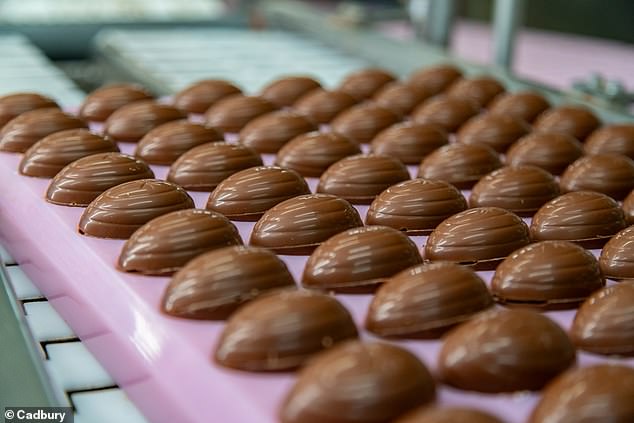“How do you eat yours?” reads Cadbury’s resurrected slogan for Creme Eggs, coinciding with the iconic chocolate maker’s 200th anniversary.
It is true that the slogan refers to its popular Easter sweet, but it also applies to other products of the brand.
The classic debate is whether chocolate should be kept in the fridge or not, something to which I could not get an absolute answer.
“We’ve been working hard on this,” says Adam Harris, head of chocolate technology platforms for wellbeing at Cadbury.
How do you eat them? Cadbury produces around 500 million Creme Eggs every year
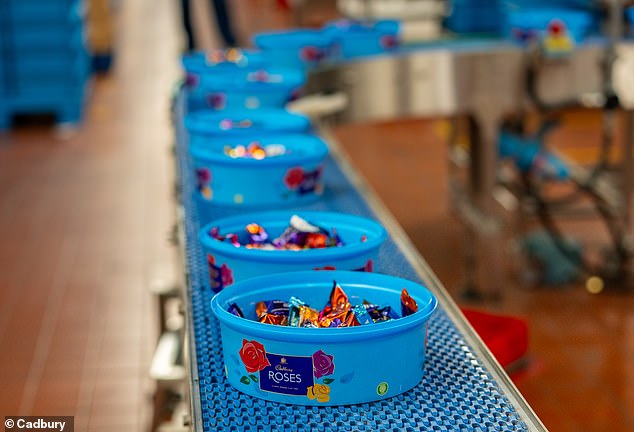
Long-lasting: Cadbury, launched in 1938, still makes its Roses chocolate tins.
“Half of consumers say they love chocolate straight from the fridge, while the other half prefer it at room temperature. It’s a matter of personal taste.”
If you want to know their opinion, it is in the refrigerator during the summer and at room temperature during the winter.
It is not a definitive answer to the debate, but it is the best I can get him to agree to during my visit to Bourneville, Birmingham, home of Cadbury, one of the most successful export stories in British history.
It would be fair to say that for many people, what springs to mind in this debate is a Cadbury bar, whether they imagine it in the fridge or not.
Having been making chocolate for two centuries, the iconic purple packaging has become a staple in homes across the country and is ubiquitous in the daily lives of millions of people – a celebration in good times and a comfort in bad.
However, for Cadbury, this is an important part of its marketing, as well as its relationship with its consumer base.
Louise Stigant, Cadbury’s UK managing director, told me: ‘There are the big moments like Christmas and Easter, but then there are those times when you get a good school report and maybe Mum has bought you a Freddo.
“I think it’s part of the rituals that people have with the most important people in their lives: their family and friends. I think that generates love (for the brand).”
Unsurprisingly, the brand is also something that many wish to protect.
After Cadbury was acquired by Kraft in 2010, rumours abounded that the Dairy Milk recipe had been changed, an accusation many still level at the chocolate maker.
For what it’s worth, Cadbury maintains that it hasn’t altered the composition of its beloved bar.
But with so much heritage behind Cadbury and a devoted following of its products, creating new products and disposing of old ones is no simple process.
Stigant added: “The balance when we think about innovation is to hold on to the heritage and love of products that people really recognise, and then bring some new and exciting innovation into their shopping baskets.”
‘Cadbury has spent 200 years building the brand in a way that people feel very close to their hearts.’
And while they are certainly keen to look back, having opened a new archives department to celebrate the anniversary, the company is also determined to continue its innovation and development.
Sarah Foden, Cadbury’s director of archives, said: “There’s a quote about an archivist always having an eye on the future and not the past, because it’s always about how things from today will be of value in the future to people looking back.”
The archives are truly impressive and a treasure trove for any history buff. However, for those with a more culinary bent, the future is bright and covered in chocolate.
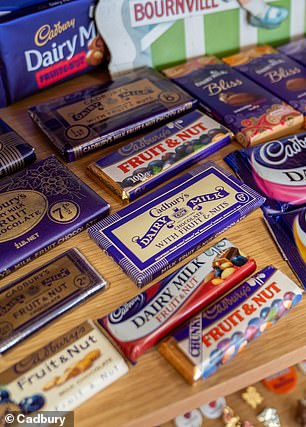
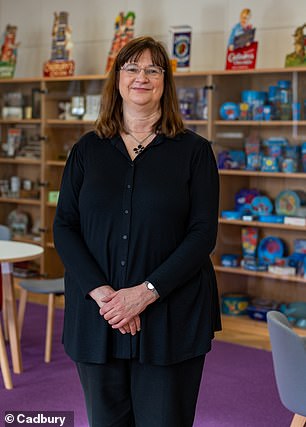
Bars of the past: Cadbury products and packaging designs have changed over the years
Over the past decade and a half, Cadbury’s parent company Mondelez has invested £275m in Cadbury’s UK operations, including expanding its research and development team to 600 staff at its Bourneville and Reading plants.
Cadbury said all its chocolate bars, which are manufactured and sold in 150 countries, begin development at its global research and development centre based at its Bourneville factory.
Adam Harris works in a large-scale home kitchen, filled with ingredients and equipment that allow him and other R&D staff to experiment with new product ideas.
He said: “We draw on a lot of different avenues of inspiration. So the culinary world is obviously a great place to start.”
“But we look beyond that. We look at consumer trends, what is happening in the world, what is happening in the fashion world, what is happening in the automotive industry. All of this will influence the lifestyle of consumers.”
“That’s why we continue to turn to consumers. If consumers say they don’t like it, we won’t launch it, because we have to make sure they’re happy and have expectations that these products will taste great,” he said.
But tastes change, says Harris, and the products Cadbury makes must evolve with them.
Admittedly, having looked through the Cadbury archives, I’m not sure how many consumers would be interested in a tray of Cadbury marzipan or, indeed, a Cadbury pineapple bar.
‘One of my favourite products was Cadbury Snaps, it was a curved chocolate, a bit like a chocolate Pringle… but in that case it didn’t meet consumer needs so we took it off the market,’ Harris told This is Money.
“A product of today may not meet the needs of tomorrow. That is why we are constantly innovating. Consumers want new opportunities, new flavours, new textures and new aromas.
One of these new products is Cadbury’s new Dairy Milk & More range, made up of ‘Caramel Nut Crunch’ and ‘Nutty Praline Crisp’.
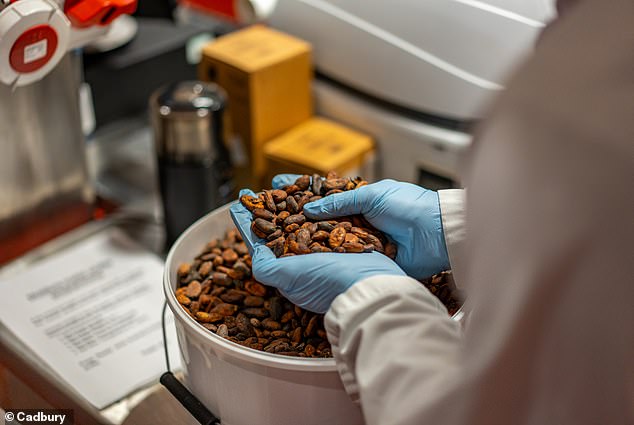
Innovation: Adam Harris says consumer tastes are constantly changing, which means R&D must find new ways to use its ingredients.
The reason for its existence? “Younger consumers want multi-sensory food experiences. The product has multiple textures, making it a different option to a Dairy Milk bar.”
But the innovation process isn’t just about Harris and his colleagues playing with ingredients in a kitchen.
Bourneville’s R&D department has its own pilot plant which it uses to test new products.
‘We do everything from what you do in your home kitchen to manufacturing.
“And at each step we have to understand what the changes are; obviously, as you scale up there is an impact on how the product is manufactured,” Harris said.
‘In the pilot plant we have everything, from laboratory level to something almost equivalent to what we have in the factory.’
This allows the innovation team to test whether their ideas can work on a near-industrial scale, proving that they can be transferred to the factory floor.
Unsurprisingly, the factory dwarfs the single pilot line, with 23 lines in total.
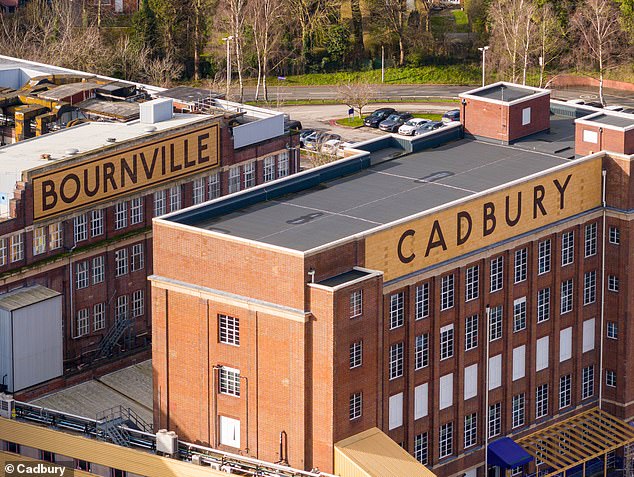
Community focus: Cadbury says its headquarters are in Bourneville, where it has been located since 1879
How Cadbury focuses on the community
While the Bourneville complex is not small, it is still surprising that Cadbury has remained on the same site since it was built in 1879, rather than moving like so many other companies do.
Of course, the brand did not start in Bourneville. John Cadbury, a Quaker, initially founded a grocery store on Bull Street in the centre of Birmingham. It was his sons, George and Richard, who decided to move the company away from the industrial heart of the city to its current headquarters in Bourneville.
“Cadbury’s headquarters are in Bourneville,” Foden tells me. “Location-wise, it’s very important for us to be here and on this wider campus.”
In fact, Cadbury says that community is at the heart of the brand. After all, the village of Bourneville surrounding the campus was built next to the factory to house its workers.
Cadbury continues to be active in the surrounding area through the Cadbury Foundation, which invests in community projects and local charities.
“If you go back 15 years, the cost of making chocolate here in Bournville was much more expensive than the average in Europe,” said Stigant, “so the investment (by Mondelez) was important to secure manufacturing at the Bournville plant, and that has allowed us to drive efficiency and ensure we can compete with other chocolate manufacturers.”
While marking 200 years of the brand is something Cadbury has celebrated greatly, its focus remains on the future and innovation.
“It’s really important that this plant, this business, is in very good condition to last another 200 years and be there for future families to enjoy Cadbury,” Stigant said.
Some links in this article may be affiliate links. If you click on them we may earn a small commission. This helps us fund This Is Money and keep it free to use. We do not write articles to promote products. We do not allow any commercial relationships to affect our editorial independence.


